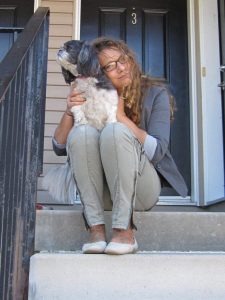Charlotte was first prescribed opioids for severe leg pain. She became dependent and grew critically ill from complications of opioid dependency. Now, as an advocate, she shares her story as a way to help others who are struggling.
Charlotte bears a tattoo of her ECG reading from when she emerged from a near fatal coma. It’s a talisman of sorts, with the phrase “have faith” incorporated into the graph lines.
“When doctors didn’t have a prognosis to tell my parents and discussions were about removing me from life support, my dad persisted each day to give it one more day, and repeatedly said “have faith”…After two weeks, on Christmas Eve 2014, I came out of the coma.”
It all started with a prescription for a fentanyl patch for pain. About 10 years ago, Charlotte experienced bone pain in her legs, which was diagnosed as rheumatoid arthritis. She was prescribed a fentanyl patch, which caused profuse sweating. She was switched to hydromorphone, another opioid used to treat pain. It was later discovered she had avascular necrosis, a painful, serious condition in which bone dies from lack of oxygen.
A chance encounter on a city bus on her way home from work changed everything. After she gave a young woman bus fare, they started talking and discovered they were both on hydromorphone.
“That’s when things changed. I was very naïve, easily influenced, gullible and insecure.”
Charlotte and the woman became immediate friends, a friendship that Charlotte later found to be destructive as she taught Charlotte how to get high off her medication and introduced her to others who took advantage of her access to prescription opioids.
Eventually, the young woman developed endocarditis, a life-threatening infection of the heart, and was taken off life support after only three days. She and Charlotte were both 23 at the time.
The people who were stealing my drugs were in the same addiction I was. We were in the same hell but what led us there was different.
When she eventually went off her medication, she found out her monthly 180 pill prescriptions were worth $7200 on the street.
Seeking a way out, Charlotte moved to a small Ontario town in 2014 where she stopped opioids entirely for six weeks before starting methadone to treat her opioid dependency. But her leg and bone pain continued and she felt progressively worse. She was eventually admitted to hospital in a coma with endocarditis.
“I was in a coma for two weeks, during which my organs started to shut down. My family thought I was going to die and started making funeral arrangements.”
Charlotte survived. “I was healed, mind, body and soul.”
She thinks a lot about the girl who didn’t make it and what might have been. “It kind of makes you wonder, what if that girl didn’t have the plug pulled. Was she written off because she was labelled an ‘addict’ and didn’t have her family there questioning the medical team? I think of her a lot.”
Charlotte, now 33, is a child and youth worker and has started volunteering to slowly get back into a regular routine.
She credits a supportive counsellor, subsidized housing and a mentor who checked in with her regularly as key to moving forward.

I did self-improvement, anything and everything I could to better myself…I developed my self-worth and I think that’s what was missing, that I didn’t love myself. I think totally differently now.
Now an advocate for naloxone use [medication that reverses opioid overdoses], Charlotte shares her experience rather than feeling ashamed. She offers support for people and their families who are struggling, giving them hope that there is a way out.
“The coma changed my life. I don’t have any negative talk or anything. I see things differently. My pain is gone and I don’t take any medication now.”
“Before all this started, I was not in a good place. Whether I took advantage of my doctor, which led me down this road, I don’t know. I had no idea what opioids were.”
All I can do is be so thankful and grateful that I am here and not another statistic, but it’s hard to recognize that without realizing many didn’t make it.
“I am really feeling blessed that things have turned around. I have a great life.”

Charlotte is using her lived experience to help others who use opioids as a patient partner with ODPRN.
“I really enjoy being part of the group and it’s giving me a sense of purpose after my situation, which was kind of horrible. It’s making something good out of something bad.”
Giving back, helping others and telling her story are central to who she is now.
As told to Kim Barnhardt
Photos supplied by Charlotte
A version of this story was originally published by The Ontario SPOR Support Unit (OSSU)
Read related stories from ODPRN and Healthy Debate at The Opioid Chapters.



The comments section is closed.